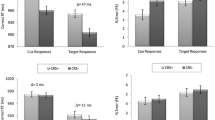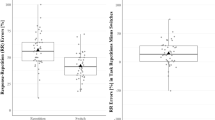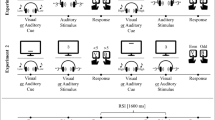Abstract
In task-switching experiments, participants switch between task rules, and each task rule describes how responses are mapped to stimulus information. Importantly, task rules do not pertain to any specific response but to all possible responses. This work examined the hypothesis that task rules, as wholes, rather than (just) specific responses are primed by their execution, such that, in the following trial, response conflicts are exacerbated when the competing responses are generated by these recently primed rules, and performance becomes relatively poor. This hypothesis was supported in two task-switching experiments and re-analyses of additional three published experiments, thus indicating Competitor Rule Priming. Importantly, the Competitor Rule-Priming effect was independent of response repetition vs. switch, suggesting that it reflects the priming of the entire task rule rather than the priming (or suppression) of specific responses. Moreover, this effect was obtained regardless of Backward Inhibition, suggesting these effects are unrelated.




Similar content being viewed by others
Notes
It is important to note that the analyses reported in this paper include a confound relating to the number of competitors in Trial N. Specifically, due to the selection criteria of the Competitor Rule-Priming effect, CRP+ included more trials with two competitor rules and fewer trials with one competitor rule than CRP– trials. This confound works in favor of the Competitor Rule-Priming effect. To assure that the Competitor Rule-Priming effect is not solely a result of this confound, we ran another repeated measures ANOVA with Congruency in Trial N, and Competitor Rule Priming as within participants independent variables, and Experiment as between-participants variable (cells were created by averaging across tasks). The Competitor Rule-Priming effect remained significant both in RT, F(1, 128) = 6.18, p = .014, η 2 p = .05, and in PE, F(1, 128) = 19.51, p < .001, η 2 p = .13. Importantly, the Competitor Rule-Priming effect did not interact with Congruency in Trial N or with the interaction Congruency in Trial N × Experiment, in RT and in PE, all Fs < 1. This analysis therefore rules out the aforementioned potential confound.
There is also the possibility that the Competitor Rule-Priming effect does not represent cost in CRP+ trials, but rather benefit in CRP− trials. Either way, the difference in performance between the two conditions can only result from priming (or the lack of priming) of the previously relevant rule, which became a competitor rule in Trial N. Specifically, it could be that in CRP+ trials, the competitor rule is primed and this leads to cost, and it could be that in CRP− trials, the competitor rule is not primed, and this leads to benefit. Although we find the former more plausible than the latter, the important issue is that only priming can explain the results obtained in this paper. Note that the question of cost vs. benefit is raised also with regard to Competitor Rule Suppression. Therefore, the question whether Competitor Rule Priming and Competitor Rule Suppression represent cost in CRP+/CRS+ trials or benefit in CRP–/CRS– trials awaits future research.
We thank Andrea Kiesel for suggesting this option.
References
Allport, A., Styles, E. A., & Hsieh, S. (1994). Shifting intentional set: exploring the dynamic control of tasks. In C. Umiltà & M. Moscovitch (Eds.), Attention and performance XV: conscious and nonconsciousinformation processing (pp. 421–452). Cambridge: MIT Press.
Allport, D. A., & Wylie, G. (2000). “Task–switching”, stimulus–response bindings, and negative priming. In S. Monsell & J. S. Driver (Eds.), Control of cognitive processes: attention and performance XVIII (pp. 35–70). Cambridge: MIT Press.
Astle, D. E., Jackson, G. M., & Swainson, R. (2012). Two measures of task-specific inhibition. The Quarterly Journal of Experimental Psychology, 65(2), 233–251.
Barutchu, A., Becker, S. I., Carter, O., Hester, R., & Levy, N. L. (2013). The role of task-related learned representations in explaining asymmetries in task switching. PLoS ONE, 8(4), e61729. doi:10.1371/journal.pone.0061729.
Botvinick, M., Braver, T., Barch, D. M., Carter, C. S., & Cohen, J. D. (2001). Conflict monitoring and cognitive control. Psychological Review, 108(3), 624–652.
Brown, J. W., Reynolds, J. R., & Braver, T. S. (2007). A computational model of fractionated conflict-control mechanisms in task switching. Cognitive Psychology, 55(1), 37–85.
Bryck, R. L., & Mayr, U. (2008). Task selection cost asymmetry without task switching. Psychonomic Bulletin and Review, 15(1), 128–134.
Druey, M., & Hübner, R. (2007). The role of temporal cue–target overlap in backward inhibition under task switching. Psychonomic Bulletin and Review, 14(4), 749–754.
Grange, J. A., & Houghton, G. (2009). Temporal cue–target overlap is not essential for backward inhibition in task switching. Quarterly Journal of Experimental Psychology, 62(10), 2068–2079.
Hsieh, S., Chang, C–. C., & Meiran, N. (2012). Episodic retrieval and decaying inhibition in the competitor-rule suppression phenomenon. Acta Psychologica, 41(3), 316–321.
Hsieh, S., & Liu, H. (2008). Electrophysiological correlates of task conflicts in task-switching. Brain Research, 1203, 116–125.
Hübner, M., Dreisbach, G., Haider, H., & Kluwe, R. H. (2003). Backward inhibition as a means of sequential task-set control: evidence for reduction of task competition. Journal of Experimental Psychology. Learning, Memory, and Cognition, 29(2), 289–297.
Jarmasz, J., & Hollands, J. G. (2009). Confidence intervals in repeated-measures designs: The number of observations principle. Canadian Journal of Experimental Psychology, 63, 124–138.
Kiesel, A., Wendt, M., & Peters, A. (2007). Task switching: on the origin of response congruency effects. Psychological Research, 71(2), 117–125.
Koch, I., Gade, M., Schuch, S., & Philipp, A. M. (2010). The role of inhibition in task switching: a review. Psychonomic Bulletin and Review, 17(1), 1–14.
Kruglanski, A. W., Shah, J. Y., Fishbach, A., Friedman, R., Chun, W., & Sleeth-Keppler, D. (2002). A theory of goal systems. In M. P. Zanna (Ed.), Advances in experimental social psychology (Vol. 34, pp. 331–378). San Diego: Academic Press.
MacLeod, C. M. (1991). Half a century of research on the Stroop effect: an integrative review. Psychological Bulletin, 109(2), 163–203.
Mayr, U., & Keele, S. W. (2000). Changing internal constraints on action: the role of backward inhibition. Journal of Experimental Psychology: General, 129(1), 4–26.
Meiran, N., & Daichman, A. (2005). Advance task preparation reduces task error rate in the cueing-task paradigm. Memory and Cognition, 33, 1272–1288.
Meiran, N., Hsieh, S., & Chang, C. C. (2011). “Smart inhibition”: electrophysiological evidence for the suppression of conflict-generating task rules during task switching. Cognitive, Affective and Behavioral Neuroscience, 11(3), 292–308.
Meiran, N., Hsieh, S., & Dimov, E. (2010). Resolving task rule incongruence during task switching by competitor rule suppression. Journal of Experimental Psychology: Learning, Memory, and Cognition, 36(4), 992–1002.
Meiran, N., & Kessler, Y. (2008). The task rule congruency effect in task switching reflects activated long term memory. Journal of Experimental Psychology: Human Perception and Performance, 34(1), 137–157.
Philipp, A. M., & Koch, I. (2006). Task inhibition and task repetition in task switching. European Journal of Cognitive Psychology, 18(4), 624–639.
Pinhas, M., Tzelgov, J., & Ganor-Stern, D. (2012). Estimating linear effects in ANOVA designs: the easy way. Behavior Research Methods, 44(3), 788–794.
Schneider, W., Eschman, A., & Zuccolotto, A. (2002). E-Prime [Computer software]. Pittsburgh: Psychology Software Tools.
Schuch, S., & Koch, I. (2003). The role of response selection for inhibition of task sets in task shifting. Journal of Experimental Psychology: Human Perception and Performance, 29, 92.
Steinhauser, M., & Hübner, R. (2006). Response-based strengthening in task shifting: evidence from shift effects produced by errors. Journal of Experimental Psychology: Human Perception and Performance, 32(3), 517–534.
Sudevan, P., & Taylor, D. A. (1987). The cuing and priming of cognitive operations. Journal of Experimental Psychology: Human Perception and Performance, 13, 89–103.
Tipper, S. P., Weaver, B., & Houghton, G. (1994). Behavioural goals determine inhibitory mechanisms of selective attention. Quarterly Journal of Experimental Psychology, 47A, 809–840.
Waszak, F., Hommel, B., & Allport, A. (2003). Task-switching and long-term priming: Role of episodic stimulus–task bindings in task-shift costs. Cognitive psychology, 46, 361–413.
Wendt, M., & Kiesel, A. (2008). The impact of stimulus-specific practice and task instructions on response congruency effects between tasks. Psychological Research, 72(4), 425–432.
Yeung, N., & Monsell, S. (2003a). Switching between tasks of unequal familiarity: the role of stimulus-attribute and response-set selection. Journal of Experimental Psychology: Human Perception and Performance, 29(2), 455–469.
Yeung, N., & Monsell, S. (2003b). The effects of recent practice on task switching. Journal of Experimental Psychology: Human Perception and Performance, 29(5), 919–936.
Acknowledgments
The research was supported by a Bi-National Taiwan–Israel research grant to Shulan Hsieh and Nachshon Meiran, by a research grant from the Israel Science Foundation to Nachshon Meiran and by a research grant from the Israeli Foundation Trustees to Maayan Katzir (Fund for Doctoral Students No. 30).
Author information
Authors and Affiliations
Corresponding author
Appendix: Selection criteria
Appendix: Selection criteria
The straightforward Competitor Rule-Priming analysis included many confounds, which involved the degree of interference in Trial N (Meiran & Kessler, 2008), the degree of interference in Trial N–1 (Botvinick et al., 2001), Competitor Rule Suppression, and competitor repetition (Meiran et al., 2011). In this section, we briefly explain how we controlled for these confounds. CRP− can only occur in trials with zero, one or two competing rules, but not with three competing rules. This is because if there are three competing rules, one of them must have been the relevant rule in Trial N–1 (given that there are four tasks). Furthermore, CRP+ can only occur in trials with one, two or three competing rules, but not with zero competing rules, because to obtain Competitor Rule Priming there must be a competitor rule to be primed. Given these considerations, we excluded trials with zero or three competing rules to remove this particular confound.
Moreover, we wanted to assure that CRP− and CRP+ trials are equally influenced by conflict in Trial N–1 (Botvinick et al., 2001) and conflict in Trial N (Meiran & Kessler, 2008). Specifically, according to conflict adaptation theory (Botvinick et al., 2001), control is recruited after a conflict. This increased control mode is carried into the following trial leading to more cautious responding, which slows down the otherwise automatic response. We, therefore, wanted to assure that CRP+ and CRP− trials are equally present following 0, 1, 2 and 3 competing rules. Similarly, because trials with two competitor rules are slower than trials with one competitor rule, we wanted to equate CRP+ and CRP− trials in this respect as well.
Additionally, since competitor rule repetition should be seen in reduced interference because the competitor rule in Trial N has already been suppressed in Trial N–1 (see Meiran et al., 2011, p. 301, for support), we wanted to assure that CRP− and CRP+ trials were equated also on competitor repetitions. Finally, we also controlled for Competitor Rule Suppression (Meiran et al., 2010). To control for the Competitor Rule Suppression confound, we excluded trials if their Trial N−1 to Trial N transition included CRS+ (or CRS−) only in CRP+ trials but not in CRP− trials, and vice versa.
As Table 4 shows, controlling for all the possible confounds when considering Trial N–1 to Trial N transitions, reduces immensely the amount of valid trials. The final number of trials is detailed in the manuscript.
Finally, note that the exclusions removed all stimulus repetitions. This resulted from a combination of several factors. Consider that we had 100 % switch trials. Also, only stimuli that had one or two competitors could repeat, because only trials with one or two competitors in Trial N were included in the analysis. Note that stimuli with one competitor were stimuli with three competitors in Trial N–1 if the competitor in Trial N was the relevant in Trial N–1. Nevertheless, trials with three competitors in Trial N–1 were removed (see Table 4). The remaining trials with one competitor always had the same competitor in Trial N–1, and therefore could only be CRP− trials with competitor repetition. Because CRP+ trials could not have competitor repetition if they had only one competitor in Trial N (see Table 4), these stimulus repetition trials were removed from the analysis. As for trials with two competitors in Trial N, these trials can involve stimulus repetition only if there were also two competitors in Trial N-1. Note that we included trials with two competitors in Trial N and two competitors in Trial N-1 only if they were CRS+ trials with competitor repetition (Table 4). In this scenario one of the competitors necessarily remained the competitor rule and the other necessarily became the relevant rule. Note that the correct responses for these two rules had to be equal in Trial N-1 (because they were both competitors). However, in Trial N, these two rules were necessarily mapped to different keys (because one rule remained the competitor rule and the other became the relevant rule), and therefore there could not be stimulus repetition in this scenario.
Rights and permissions
About this article
Cite this article
Katzir, M., Ori, B., Hsieh, S. et al. Competitor Rule Priming: Evidence for priming of task rules in task switching. Psychological Research 79, 446–462 (2015). https://doi.org/10.1007/s00426-014-0583-3
Received:
Accepted:
Published:
Issue Date:
DOI: https://doi.org/10.1007/s00426-014-0583-3




